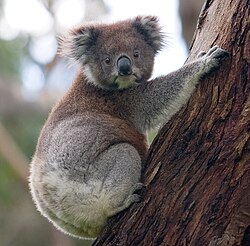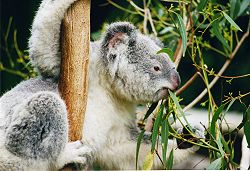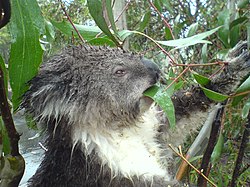Koala
A Koala (Phascolarctos cinereus) is a plant-eating marsupial. It lives in the eucalyptus forests of eastern Australia.[5] They are the only living species in the family Phascolarctidae.[6] They are related to the wombats.
| Koala | |
|---|---|

| |
| Conservation status | |
| Scientific classification | |
| Kingdom: | |
| Phylum: | |
| Class: | |
| Infraclass: | |
| Order: | |
| Suborder: | |
| Family: | |
| Genus: | |
| Binomial name | |
| Phascolarctos cinereus (Goldfuss, 1817)
| |

Koalas are often called koala bears, because a koala looks like a small bear or teddy bear. However, it is not a bear, it is quite a different type of animal.[5][7]
Appearance
Koalas have brownish-grey or silver-grey fur, and a big pink, dark red or/and black nose. They have sharp claws which help them to climb.[8]
Koalas also have finger prints which look the same as human finger prints.[9] Finger print experts have had difficulty in being able to tell if the prints are from a human or koala.[9] Finger prints are rare among mammals that climb trees. Scientists do not know why the koala has them, but their best guess is that it helps the koala choose leaves to eat.[9]
Life
Koalas are mostly active at night. They live in trees and are rarely found on the ground. Koalas have two unusual characteristics. They eat leaves of eucalyptus trees. Koalas do not drink often, they get most of their water from the eucalyptus leaves they eat. Eucalyptus leaves are poisonous, but koalas do not get poisoned. This is because they have certain bacteria in their digestive tract that can detoxify the poison in the leaves. Koalas, however, have to sleep long hours because eucalyptus leaves do not produce much energy and also because the digestive process takes a long time.
Koalas have a peculiar way of cooling themselves. Unlike humans who sweat and other animals, which either pant or lick their fur to stay cool, koalas reduce their body heat by hugging a tree. The temperature of the trunks of certain trees is up to 9 degrees Celsius lower than the air temperature. Koalas prefer to stay on these trees on a hot day even if they do not have the tastiest leaves.
Koalas live alone most of the time, but they have a social hierarchy with the other koalas who live near.
After a pregnancy of 35 days, the newly born koala is about a quarter of an inch long, and is born with no ears, eyes, or hair. It crawls into its mothers pouch on its own. After 12 months the young koala is old enough that it does not go into its mother's pouch or need milk anymore. The female koala can have another baby then. Young koalas usually leave their mothers when they are 18 months old, but if their mother does not have another baby they sometimes stay for up to three years. Koalas become mature when they are about two years old, but they often have their first baby after another two years.
Other information
The koala is not an endangered species, but it is a near vulnerable species. One reason is the loss of habitat, which means that koalas have less space to live. In some places there are very few koalas left. But there are also places, such as French Island (Victoria), with too many koalas that eat too much.[10] Because of this the eucalyptus trees and other animals are in danger. A study looking at koala numbers at 1800 sites for 20 years, shows that the number of koalas is falling. The study, by the Australian Koala Foundation, estimates that there are only about 50,000 koalas left.[10] there is over 500 types of gum trees in the world, however, koalas only eat 4-6 types that they prefer.
Chlamydia
Many koalas are infected with Chlamydia. This is affecting the survival of the species. Koalas on French Island do not have the disease, and so groups of them are often moved to the mainland to repopulate some areas. The disease can cause blindness, pneumonia, urinary tract infections and reproductive tract infections.[11]
References :3
- ↑ "Advocates hail koala 'vulnerable' status". News.brisbanetimes.com.au. 29 April 2012. Retrieved 2 May 2012.[dead link]
- ↑ "Advocates hail koala vulnerable status". Sydney Morning Herald. 29 April 2012. Retrieved 2 May 2012.
- ↑ Koalas added to threatened species list. Australia: ABC. 30 April 2012. http://www.abc.net.au/news/2012-04-30/koala-listed-as-vulnerable/3980216/?site=sydney. Retrieved 2 May 2012.
- ↑ "Koalas to be listed as threatened amid rapid decline". Thecourier.com.au. 27 April 2012. Retrieved 2 May 2012.[dead link]
- ↑ 5.0 5.1 "Koala". National Geographic. 11 April 2010. Retrieved 2011-04-16.
- ↑ Groves, Colin; Wilson D.E. & Reeder D M. (eds) 2005. ed. Mammal species of the world. 3rd ed, Johns Hopkins University Press, pp. 43. ISBN 0-801-88221-4
- ↑ "Koala (Phasclarctas Cinereus)". AustralianFauna.com. Archived from the original on 2011-12-31. Retrieved 2011-04-16.
- ↑ "Koala - profile". Department of Environment and Conservation New South Wales. Archived from the original on 2011-04-23. Retrieved 2011-04-16.
- ↑ 9.0 9.1 9.2 Wighton, Dan, Koalas have fingerprints so much like a human they’ve tricked CSIs, 11 September 2015, http://www.techly.com.au/2015/09/11/koalas-fingerprints-much-like-human-theyve-tricked-csis/ Archived 2015-09-12 at the Wayback Machine
- ↑ 10.0 10.1 Morton, Adam (November 10, 2009) (in English). Fewer than 50,000 koalas feared left. The Age. pp. 4. http://www.theage.com.au/environment/fewer-than-50000-koalas-feared-left-20091109-i5dg.html. Retrieved 2009-12-01.
- ↑ "Information on Koalas. This Koala information is regularly updated". thekoala.com.
Koala Media
Female koala (Phascolarctos cinereus) grooming herself up in a gum tree.
A wild Koala I found on the edge of the carpark atop Mt Macedon. He was not in any sort of captivity, but was still tolerant of us giving him a quick pat and taking pictures. Everyone else was too busy rushing to the cafe to notice the Koala. He was first sitting on the ground, then over a half hour or so made his way a couple of feet up a tree to eat.
Other websites
| Wikimedia Commons has media related to Lua error in Module:Commons_link at line 62: attempt to index field 'wikibase' (a nil value).. |










